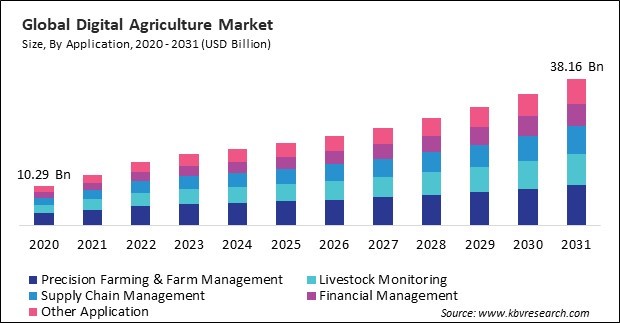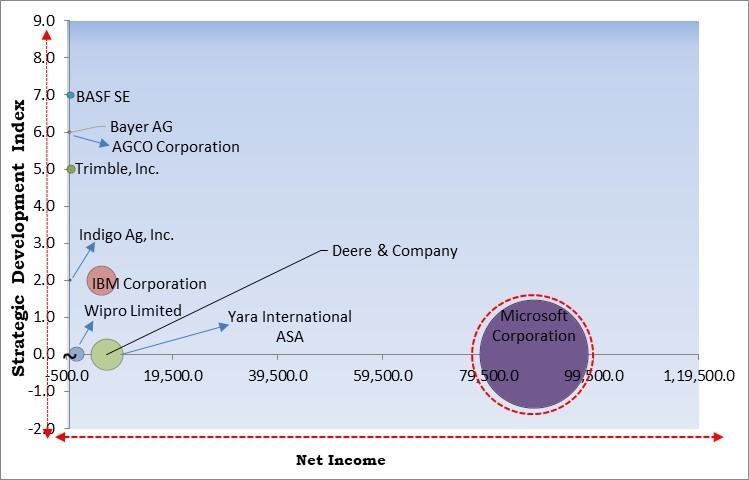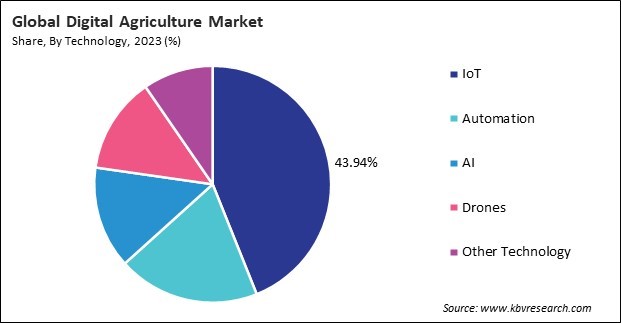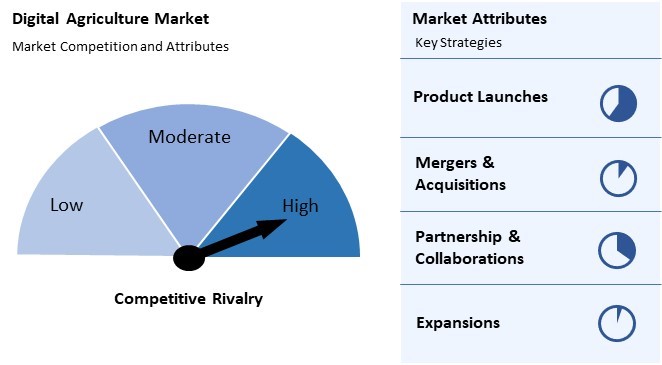“Global Digital Agriculture Market to reach a market value of USD 38.16 Billion by 2031 growing at a CAGR of 9.9%”
The Global Digital Agriculture Market size is expected to reach $38.16 billion by 2031, rising at a market growth of 9.9% CAGR during the forecast period.
Early technological adoption, a well-established agricultural infrastructure, and significant investments in precision farming and smart agriculture solutions drive the North America segment. Farmers in the U.S. and Canada leverage advanced technologies such as IoT, AI, drones, and automation to enhance productivity, reduce costs, and meet sustainability goals. Thus, the North America segment procured 35% revenue share in the market in 2023. Government initiatives and subsidies encouraging the adoption of digital farming practices, with widespread access to high-speed internet connectivity and strong research and development (R&D) capabilities, have further accelerated market growth in this region.

The major strategies followed by the market participants are product launches as the key developmental strategy to keep pace with the changing demands of end users. For instance, In 2025, February, BASF SE unveiled three farming solutions, including Xarvio Field Manager for Fruits and Veggies, a digital crop optimization platform. BASF integrates seeds, crop protection, and digital intelligence to enhance yield and efficiency. The company aims to expand its support for fruit and vegetable growers worldwide. Additionally, In December, 2024, Bayer AG unveiled FieldView in Mexico, expanding its digital agriculture platform to optimize crop management. Used in 27+ countries, FieldView helps farmers analyze real-time data, improve efficiency, and enhance sustainability. Bayer aims to strengthen Mexican agriculture by maximizing resources and supporting informed decision-making.
Based on the Analysis presented in the KBV Cardinal matrix; Microsoft Corporation is the forerunner in the Digital Agriculture Market. Companies such as Deere & Company, IBM Corporation and Wipro Limited are some of the key innovators in Digital Agriculture Market.

Precision farming, also known as precision agriculture, leverages advanced technologies such as Global Positioning System (GPS), Internet of Things (IoT), and Artificial Intelligence (AI) to enhance agricultural practices. Precision farming allows for the optimization of inputs such as water and fertilizers in accordance with specific field conditions through the use of GPS-guided machinery and data analytics. Higher crop yields and more effective use of resources are the outcomes of this. Hence, the benefits of precision farming are augmenting the demand for digital agriculture solutions.
Additionally, by formulating supportive policies, governments can encourage the integration of advanced technologies into agriculture, leading to increased efficiency and sustainability. For instance, a study highlighted that repurposing a small portion of government agricultural spending towards targeted expenditures on research and development (R&D) and incentives for innovation adoption could reduce poverty, lower the cost of healthy diets, and decrease the land required for agriculture. Thus, these factors are supporting the growth of the market.
The adoption of digital agriculture technologies comes with a significant financial burden, particularly for small and medium-scale farmers. Precision farming tools, IoT-enabled sensors, drones, satellite imaging, and automated irrigation systems are key innovations transforming the agricultural sector. However, these technologies require substantial upfront investments, including hardware, software, installation, and training costs. Unlike traditional farming practices that involve minimal technological infrastructure, digital agriculture demands a shift towards capital-intensive operations, which many farmers find difficult to afford. Hence, the high initial investment cost remains one of the most critical factors hampering the large-scale implementation of digital agriculture technologies.

The leading players in the market are competing with diverse innovative offerings to remain competitive in the market. The above illustration shows the percentage of revenue shared by some of the leading companies in the market. The leading players of the market are adopting various strategies in order to cater demand coming from the different industries. The key developmental strategies in the market are Acquisitions, and Partnerships & Collaborations.
Free Valuable Insights: Global Digital Agriculture Market size to reach USD 38.16 Billion by 2031
On the basis of application, the market is divided into precision farming & farm management, livestock monitoring, supply chain management, financial management, and others. The precision farming & farm management segment acquired 29% revenue share in the market in 2023. With growing concerns over food security and sustainability, farmers are adopting precision farming tools to optimize input usage such as water, fertilizers, and pesticides, thereby reducing operational costs and environmental impact.
By technology, the market is segmented into AI, drones, IoT, automation, and others. The automation segment garnered 19% revenue share in the market in 2023. Automated machinery, including self-driving tractors, robotic harvesters, and automated irrigation systems, helps farmers perform repetitive tasks more precisely and consistently. Automation reduces operational costs, increases scalability, and enhances efficiency in large-scale farming operations.

Based on component, the market is classified into hardware, software, and service. The hardware segment garnered 41% revenue share in the market in 2023. Equipment such as sensors, drones, automated irrigation systems, and GPS-guided machinery allow farmers to efficiently manage resources, reduce waste, and improve crop yields.

The Digital Agriculture Market is highly competitive, driven by technological advancements, industry automation, and increasing demand for real-time process analysis. Key players focus on innovation, mergers, and acquisitions to expand market presence. Attributes influencing the market include precision, non-destructive analysis, speed, and adaptability to diverse industries such as pharmaceuticals, food & beverages, chemicals, and oil & gas. Integration of AI and IoT enhances spectroscopy applications, enabling real-time monitoring and predictive analytics, further fueling market growth and competition.
Region-wise, the market is analyzed across North America, Europe, Asia Pacific, and LAMEA. The Europe segment acquired 30% revenue share in the market in 2023. The Europe segment is primarily driven by stringent regulations on sustainable farming, environmental conservation, and food safety, which encourage the adoption of digital agriculture technologies. The European Union’s policies, including the Common Agricultural Policy (CAP) and the European Green Deal, promote precision farming, data-driven solutions, and eco-friendly agricultural practices.
| Report Attribute | Details |
|---|---|
| Market size value in 2023 | USD 18.42 Billion |
| Market size forecast in 2031 | USD 38.16 Billion |
| Base Year | 2023 |
| Historical Period | 2020 to 2022 |
| Forecast Period | 2024 to 2031 |
| Revenue Growth Rate | CAGR of 9.9% from 2024 to 2031 |
| Number of Pages | 294 |
| Number of Tables | 393 |
| Report coverage | Market Trends, Revenue Estimation and Forecast, Segmentation Analysis, Regional and Country Breakdown, Competitive Landscape, Market Share Analysis, Porter’s 5 Forces Analysis, Company Profiling, Companies Strategic Developments, SWOT Analysis, Winning Imperatives |
| Segments covered | Application, Technology, Component, Region |
| Country scope |
|
| Companies Included | Microsoft Corporation, BASF SE, Indigo Ag, Inc., AGCO Corporation, Wipro Limited, Yara International ASA, Bayer AG, IBM Corporation, Trimble, Inc. and Deere & Company |
By Application
By Technology
By Component
By Geography
This Market size is expected to reach $38.16 billion by 2031.
Growing Adoption of Precision Farming are driving the Market in coming years, however, Substantially High Initial Investment Costs restraints the growth of the Market.
Microsoft Corporation, BASF SE, Indigo Ag, Inc., AGCO Corporation, Wipro Limited, Yara International ASA, Bayer AG, IBM Corporation, Trimble, Inc. and Deere & Company
The expected CAGR of this Market is 9.9% from 2023 to 2031.
The IoT segment is leading the Market by Technology in 2023; thereby, achieving a market value of $16.03 billion by 2031.
The Asia Pacific region dominated the Market by Region in 2023; thereby, achieving a market value of $9.79 billion by 2031.
Our team of dedicated experts can provide you with attractive expansion opportunities for your business.

 Drivers
Drivers
 Restraints
Restraints
 Opportunities
Opportunities
 Challenges
Challenges
